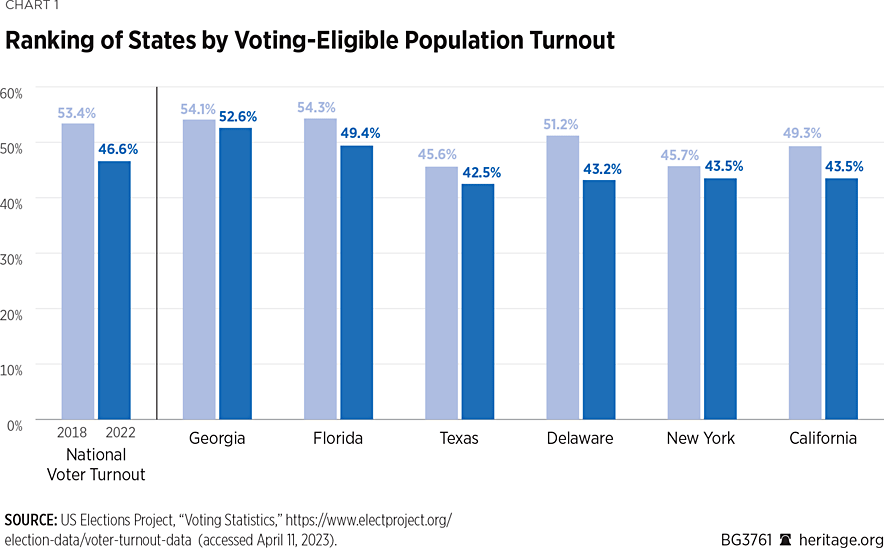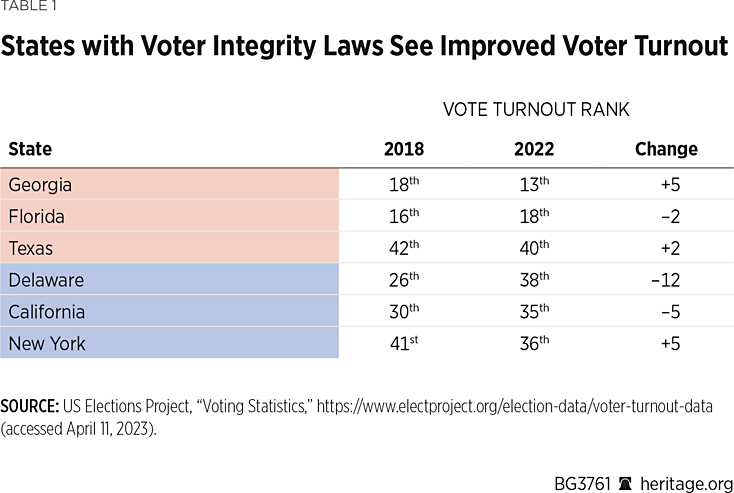The latest data from the 2022 election demonstrate once again that the claim that commonsense election reforms of the sort passed by states such as Georgia, Florida, and Texas would “suppress” the turnout of the states’ voters is false. The data are just the most recent evidence that reinforces other long-term analyses of this issue.
For example, in 2019, the National Bureau of Economic Research released a report examining the effect of voter identification (ID) laws based on 10 years of turnout data from 2008 to 2018 in all 50 states.REF The report concluded that voter ID “laws have no significant negative effect on registration or turnout, overall or for any subgroup defined by age, gender, race, or party affiliation.”REF
In 2023, another study on voter ID laws was published in the Proceedings of the National Academy of Sciences. This study concentrated on the claim made by opponents of such laws that ID requirements help Republican Party candidates and hurt Democrat Party candidates because of the supposedly “disproportionate burden they place on historically disadvantaged groups such as the poor and people of color.”REF

The authors examined the political “parties’ electoral fortunes in races at the state level (state legislatures and governorships) and federal level (United States Congress and president) during 2003 to 2020.”REF In other words, they examined whether ID requirements helped or hurt the candidates of the two major political parties in state and federal elections. They found that when ID laws were first implemented, they “produced a Democratic advantage, which weakened to near zero after 2012.”REF In fact, such ID requirements seem to increase turnout since they “motivate and mobilize supporters of both parties.”REF
The U.S. Census Bureau’s election survey of voter turnout in the 2020 presidential election is also worth noting because it clearly demonstrated that there has been no wave of “voter suppression” keeping American voters from registering and voting.REF Instead, the Census Bureau reported that the turnout in the 2020 election at 66.8 percent was the “highest voter turnout of the 21st century,” just short of the record turnout of 67.7 percent of voting-age citizens in the 1992 election. This was higher than the 63.6 percent citizen population turnout in President Barack Obama’s first election as reported by the Census Bureau.REF
The Census survey shows that there was higher turnout among all races in 2020 when compared to the 2016 election. Black citizens turned out at 62.6 percent, compared to only 59.4 percent in 2016. Asian American citizens turned out at 59.7 percent in 2020, an almost 11 percentage point increase from 2016 when 49 percent turned out to vote.REF Hispanic citizens voted at a rate of 53.7 percent compared to 47.6 percent in 2016.REF
It is important to keep in mind that turnout increases or decreases from one election to another, depending on the interest of the electorate in particular candidates or referenda as well as many other factors such as the state of the economy, the amount of political expenditures that may highlight particular candidates and support get-out-the-vote campaigns, or other issues that may be in the news at a particular time. Additionally, given the large number of aliens in the country today, data based on the citizen or voting eligible population can provide a more accurate assessment of turnout than is provided by data based on voting-age population.
Georgia
Election Reforms. Georgia currently ranks second in the nation in terms of having the best laws and practices designed to secure its elections with a score of 83 out of a possible 100 in The Heritage Foundation’s Election Integrity Scorecard.REF The Scorecard compares the election laws and regulations of each state that affect the integrity of the election process to a set of “best practices” recommendations developed by The Heritage Foundation’s election experts.REF
One of Georgia’s first major election reforms, requiring a government-issued photo ID,REF was effective in local elections in 2007 and for the first time in a presidential election in 2008. As outlined in a prior Heritage Foundation Issue Brief, not only did voter turnout not go down, but the turnout of all voters, including black and Hispanic voters, went up dramatically in that election compared to the 2004 presidential election with similar increases in the 2010 congressional election.REF
Georgia voters can satisfy the state’s voter ID requirements for in-person voting by providing any of the following: a Georgia license (even one that is expired); a state or federal government photo ID; a student ID from a Georgia public college or university; an employee ID card for any position in local, state, or federal government; a U.S. passport; a military ID; or a tribal photo ID.REF If you find yourself in the exceedingly rare position of not possessing any of these, any county registrar’s office or Department of Driver Services office will provide a photo voter ID card free of charge.
For absentee ballots, voters can (1) submit a photocopy of one of those forms of photo ID; (2) provide the serial number of their driver’s license or free voter ID card; or (3) submit a photocopy of a current utility bill, bank statement, paycheck, government check, or other government document with the voter’s name and address on it.REF
According to the US Elections Project, the turnout of the voting-eligible population (VEP) nationally in 2008 was 1.5 percentage points higher than the turnout in the 2004 presidential election. Yet the VEP turnout in Georgia, with its new in-person ID requirement in place for the first time in a presidential election, was 6.1 percentage points higher in 2008 than it was in 2004.REF New York and California, which have no ID requirements, had increases of only 1.1 and 2.1 percentage points, respectively, and Georgia had a higher turnout (62.5 percent) than either New York (59.6 percent) or California (61.7 percent).REF
Similarly, the turnout of the VEP nationally went up slightly in the 2010 congressional election compared to 2006 by 0.5 percentage points. Yet VEP turnout in Georgia in 2010, again with the ID requirement in place for the first time in a congressional election, was 5.5 percentage points higher than the turnout in 2004—far above the national increase.REF
2022 Election. In 2021, the Georgia legislature implemented another round of election reforms in SB 202, which included extending the ID requirement for in-person voting to absentee ballots.REF The bill was harshly criticized by, among others, gubernatorial candidate Stacy Abrams, who claimed the “burdensome ID” and other requirements in the new law would “suppress” the turnout of “eligible voters.”REF President Joe Biden called SB 202 the new “Jim Crow” and claimed that its “rigid” ID “restrictions on casting absentee ballots” would “effectively deny the right to vote to countless voters.”REF
The President even made the historically outrageous claim in a speech in Atlanta that anyone in favor of election reforms such as the ID requirements implemented in Georgia are in the same camp as former Alabama Governor George Wallace; the infamous former Commissioner of Public Safety in Birmingham, Bull Connor; and the President of the Confederacy, Jefferson Davis. Biden repeated the myth that such reforms suppress votes.REF Clearly the American public does not agree. Polling consistently shows that a majority of all voters support ID requirements no matter what their race, ethnicity, or party affiliation might be.

It is hard to equate support for such reforms with being a supporter of George Wallace, Bull Connor, or Jefferson Davis when a 2021 Rasmussen poll shows that 74 percent of whites, 69 percent of blacks, and 82 percent of other minorities say that voters “should be required to show photo identification before being allowed to vote.”REF Gallup found similar results in 2022 with 80 percent of whites and 74 percent of “people of color” supporting voter ID.REF
Another poll by the Honest Elections Project found that support for voter ID has actually gone up since the organization first started polling this issue with 81 percent of voters supporting such a requirement, including 77 percent of black voters, 78 percent of Hispanic voters, and 81 percent of lower-income voters—and that support includes applying an ID requirement to absentee ballots. According to the Honest Elections Project poll, 77 percent of respondents said it would be “easy” to comply with the type of absentee ballot ID requirement that Georgia, Florida, and Texas have implemented.REF
The 2022 congressional election in Georgia was conducted with all of the reforms in place that the legislature passed in 2021 and that Biden and Abrams criticized. Courts rejected numerous legal challenges, including one by the U.S. Department of Justice, because none of the challengers provided any evidence that justified issuing an injunction against the law’s implementation.
A voter survey conducted by the University of Georgia’s Survey Research Center found that all of the criticisms of these reforms were completely unfounded.REF When asked about their overall voting experience in the 2022 election, 72.6 percent of black Georgians said their experience was “excellent,” and another 23.6 percent said it was “good.” The percentage of black voters who said they had a “poor” experience voting was 0.0 percent—a remarkable number that one does not often see in polls and surveys. By comparison, 72.7 percent of white voters had an “excellent” experience, 23.3 percent had a “good” experience, and 0.9 percent had a “poor” experience. The differences in the experiences of white and black voters were statistically insignificant; it is clear from the survey that almost no voters had any problems voting with the new ID and other changes in place.
The survey also asked voters another crucial question about comparing their voting experience in 2022 to their voting experience in 2020 before the election reforms were implemented. The responses to that question once again show that the criticisms of SB 202 were unwarranted. Of black voters, 19.1 percent said their experience in 2022 was actually “easier” than in 2020, and another 72.5 percent said there was “no difference” for a total of 91.6 percent. White voters had similar responses: 13.3 percent said their experience was “easier,” and 80.1 percent said there was “no difference” for a total of 93.4 percent—again, a statistically insignificant difference other than a larger percentage of black voters than white voters saying their voting experience was easier after the reforms were implemented.REF
One other relevant issue is wait times at polling places. Stacy Abrams claimed that voters in Georgia “stood in lines for hours because of voter suppression tactics,”REF and general complaints about long lines have been voiced for years by some activists.
While there is no doubt that long lines do occasionally occur in our elections, usually due to unexpectedly high turnout, they are not the norm. In 2015, the Caltech/MIT Voting Technology Project released a report on the 2008 and 2012 presidential elections.REF It found that 36.8 percent of voters in 2008 and 37.3 percent of voters in 2012 had no wait time at all. Another 27.6 percent and 31.8 percent, respectively, waited less than 10 minutes. Of the remaining voters, 19 percent waited between 10 and 30 minutes in 2008; 18.4 percent waited for the same amount of time in 2012; and 10.3 percent and 8.6 percent, respectively, waited between 31 minutes and an hour to vote in those two elections. All of this averaged out to a minimum waiting time for voters in 2008 of a little under 17 minutes compared to less than 14 minutes in 2012.REF
What happened with respect to wait times in Georgia in 2022 with the new reforms in place? The University of Georgia survey found that 32.2 percent of black voters had no waiting time whatsoever, 36.5 percent waited less than 10 minutes, and another 27.3 percent waited between 10 and 30 minutes. Thus, 96 percent of black voters voted within 30 minutes of arriving at their polling places, and close to 70 percent voted within 10 minutes. In other words, black voters in Georgia in 2022 were better off in this regard than voters in either the 2008 or 2012 elections as reported in the CalTech/MIT study, which showed that in 2008 and 2012, only 83.4 percent and 87.5 percent, respectively, of voters nationally were able to cast their ballots within 30 minutes. That is the acceptable benchmark according to President Obama’s Presidential Commission on Election Administration.REF
White voters in Georgia had an almost identical experience in 2022, according to the University of Georgia survey: 41.1 percent reported no wait time; 36.3 percent reported a wait time of less than 10 minutes, and 17.8 percent reported wait times of 10 minutes to 30 minutes. Similar to black voters, 95.2 of white voters voted within 30 minutes of arriving at their polling places, and a little over 77 percent voted within 10 minutes. Clearly, the claim that the Georgia election reforms would cause long lines at polling places, especially for black voters, turned out to be completely wrong.
The reported turnout in Georgia in the 2022 election also does not support the predictions that Biden, Abrams, and others made about the state’s 2021 election reform bill. Nationally, according to the US Elections Project, VEP turnout went down from 50 percent in the 2018 midterm election to 46.6 percent in 2022, a decline of 3.4 percentage points.
In Georgia, the VEP turnout in 2018 was 54.1 percent (4.1 percentage points above the national turnout rate), and in 2022, it was 52.6 percent (6 percentage points above the national turnout rate and the 13th highest turnout rate in the country). Thus, while the nation as a whole saw a decline of 3.4 percentage points in turnout from 2018 to 2022, the decline in Georgia was only 1.5 percentage points with the new reforms in place, and even with this slight decline, Georgia’s turnout rate was well above the national average.
By way of comparison, New York has a score of 46 in the Heritage Election Integrity Scorecard and is currently ranked 43rd in the nation, making it one of the worst states in terms of insecure elections.REF Unlike Georgia, New York has no voter ID requirement for either in-person or absentee balloting, yet the state had lower VEP turnout than Georgia in both the 2018 and 2022 elections at 45.7 percent and 43.5 percent, respectively. Its decline of 2.2 percentage points was larger than Georgia’s slight decline. In addition, Georgia had the 13th highest turnout, in 2022, and New York ranked 36th.
It is therefore quite ironic that New York’s senior Senator, Charles Schumer (D), the majority leader of the U.S. Senate, called Georgia’s reforms “voter suppression” and said they “smack of Jim Crow rearing its ugly head once again.”REF The data clearly show time and time again that those who claim that commonsense measures like voter ID will prevent voters from being able to cast ballots are spreading a lie.REF
California also has no ID requirement, received an embarrassing score of only 30 out of a possible 100 points in the Heritage Election Integrity Scorecard, and is currently ranked 49th out of 51 (although not a state, the District of Columbia is included in the Scorecard because it has three Electoral College votes),REF making it the worst state in the nation in terms of election integrity except for Nevada (50th)REF and Hawaii (51st).REF Representative Nancy Pelosi (D–CA) has unfairly criticized the election reform efforts of states like Florida, Georgia, and Texas as an effort to “undermine our democracy” and “undermine the voting power.”REF
Yet her home state had a lower VEP turnout than Georgia’s in 2018 (49.3 percent) and a far lower VEP turnout in 2022 (43.5 percent), more than 9 percentage points lower than Georgia’s in 2022. The turnout decline of 5.8 percentage points from 2018 to 2022 in California was far larger than Georgia’s decline. Its disappointing turnout was so low that it ranked 35th in the nation. Perhaps what is “undermining democracy” in Pelosi’s home state of California is its refusal to implement the most basic security measures to protect the integrity of the election process and help to ensure public confidence in the honesty of its elections.
Georgia’s turnout also beat the turnout in President Biden’s home state, which has no effective ID requirement.REF Delaware has a score of 52 and is currently ranked 32nd in the country in the Heritage Election Integrity Scorecard.REF Yet according to the US Elections Project, Delaware’s VEP turnout declined from 51.2 percent in 2018 to 43.2 percent in 2022. Its turnout was thus lower than Georgia’s in both elections, and its decline of 8 percentage points was far larger than Georgia’s decline of only 1.5 percentage points. Delaware’s turnout made it 38th in the nation, putting it behind even California and New York. Biden’s “Jim Crow 2.0” speech might have been more appropriate given in Dover, Delaware, instead of Atlanta, Georgia.
Georgia saw a record number of votes cast in the 2022 election. According to the Georgia Secretary of State, 3,964,926 individuals cast votes in the election out of 6.9 million registered voters. This was more than the 3,949,905 individuals who voted in the 2018 midterm congressional election out of 6.4 million registered voters.REF Not only did the number of votes cast increase after the 2021 election reforms became effective, but half a million new voters registered in the state.
Florida
Florida is currently tied for sixth place in the Heritage Election Integrity Scorecard and has a score of 78.REF In 2022, the Florida legislature passed an election reform bill, SB 524, to improve the security of the state’s election process.REF SB 524 was a comprehensive bill that made many changes, such as banning private funding of election offices by political donors and strengthening the voter ID requirements for absentee ballots. The same type of false voter suppression claims were made about Florida’s new law that were made about Georgia’s recent election integrity law, with the head of the League of Women Voters of Florida calling it “undemocratic, unconstitutional, and un-American.”REF
Florida provides a comprehensive list of acceptable forms of voter ID for in-person voting that include a Florida driver’s license, a non-driver photo ID card issued by the Florida Department of Highway Safety and Motor Vehicles, a U.S. passport, debit or credit card with photo, military identification, student ID, retirement center ID, neighborhood association card, military ID, veteran health identification card, public assistance card, concealed carry permit, or government employee ID card.REF Voters who request an absentee ballot must include either the serial number of their Florida driver’s licenses or state ID cards or the last four digits of their Social Security numbers.REF
Yet in the 2022 election with the new provisions in place, when the national VEP turnout was 46.6 percent, VEP turnout in Florida was 49.4 percent, according to the US Elections Project, or 2.8 percentage points above the national turnout rate. Florida’s VEP turnout rate was the 18th highest in the nation according to the US Elections Project—higher than the turnout rates for California, New York, and Delaware.
Texas
Texas is currently ranked ninth in the Heritage Election Integrity Scorecard and has a score of 76.REF In 2021, the state legislature passed a comprehensive election reform bill, SB 1, that is similar to those passed int Florida and Georgia, including, among other reforms, extending the state’s voter ID requirement to absentee ballots.REF President Biden called it “wrong and un-American” and “an assault on democracy,” and Texas State Senator Borris Miles (D) repeated Biden’s historically insulting reference when he claimed the Texas bill was “Jim Crow 2.0.”REF
Texas accepts multiple forms of voter ID including a Texas driver’s license, a Texas personal ID card issued by the Department of Public Safety, a Texas handgun license, a citizenship certificate, a military ID, a U.S. passport, or the free Texas election ID certificate that is also issued by the Department of Public Safety.REF Even if you do not have any of these readily accessible forms of identification, you can still vote in Texas by filling out a form in which you declare that a “reasonable impediment” prevented you from obtaining a photo ID and you present a birth certificate, utility bill, bank statement, government check, paycheck, or other government document that has your name and address.
To use absentee ballots, just as in Florida and Georgia, voters must provide the serial numbers of their Texas driver’s licenses, personal ID cards, or election ID certificates. Alternatively, they can provide the last four digits of their Social Security numbers. Voters who do not have Social Security numbers will still be able to vote by simply affirming that they do not have any of these ID documents.REF
In 2018, before these latest reforms were in place, the VEP turnout in Texas, according to the US Elections Project, was 45.6 percent, or 4.4 percentage points below the national turnout rate. In 2022, the VEP turnout in Texas was 42.5 percent, a decrease of 3.1 percentage points, which was smaller than the national decrease of 3.4 percentage points.
Texas, with its new provisions in place, went from being ranked 42nd in the nation in terms of VEP turnout in 2018 to being ranked 40th in 2022. Texas thus slightly improved its turnout relative to other states. In other words, during the 2022 election, there was only a 0.7 percentage point difference between turnout in President Biden’s home state of Delaware (ranked 38th in the nation at 43.2 percent) and Texas, the state he criticized (ranked 40th at 42.5 percent).
When two states like Delaware and Texas have such similar turnouts, it is an unfair and unjustified criticism to claim that one of them is imposing Jim Crow 2.0 while the other gets no criticism whatsoever of its election rules. This is particularly true when Texas improved its standing in comparison to other states in terms of its electoral turnout from 2018 to 2022, while states like Delaware and California lost ground in comparison to other states. Delaware dropped from 26th to 38th place, and California dropped from 30th to 35th place.
Conclusion
As numerous studies and turnout data from states that have improved the security of their election process through commonsense reforms have shown, making integrity a primary goal of the laws and regulations governing the election process does not “suppress” votes. In fact, it seems to increase voter confidence in elections, which in turn can help to increase turnout. As the Supreme Court said in 2008 when it found Indiana’s voter ID law to be constitutional and not to be a burden on voters, maintaining “public confidence in the integrity of the electoral process has independent significance, because it encourages citizen participation in the democratic process.”REF
Hans A. von Spakovsky is Manager of the Election Law Reform Initiative and a Senior Legal Fellow in the Edwin Meese III Center for Legal and Judicial Studies at The Heritage Foundation.



